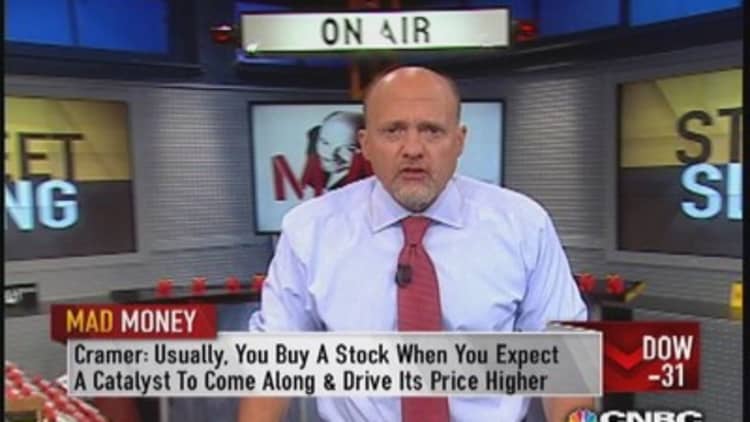
There are distinct circumstances for trading and distinct circumstances for investing. Jim Cramer says they should not be confused.
Although the "Mad Money" host believes individual individuals can generate huge returns without ever trading a day in their lives, he also understands that trading has its appeal.
Trades often present the opportunity to make significant gains in a short amount of time, however they also present greater risk.
So, when does Cramer invest and when does he trade?
"If I were to buy a stock as a trade, I'd be buying it for a specific catalyst, some anticipated future event that I think will drive the stock higher," Cramer explained.
Those events can be company specific, such as better than expected earnings or promising or they can be somewhat macro-economic such as the .
However, whatever the catalyst may be, "when you make a trade going into it, you know that there's a moment to buy—before the catalyst—and a moment to sell, after the catalyst happens," Cramer explained.
And, here's the important part. "Sometimes your trades won't work out; the event you're waiting for won't happen, or maybe the data point you're expecting simply turns out to be less positive than you expected." That doesn't matter. "Once the window of opportunity closes you must sell a trade whether you made money or lost money," said Cramer.
That's so important Cramer said it again, "Hopefully, you'll turn out to be right but if you turn out to be wrong, you still need to sell."
If it's hard for you to sell a stock that's gone down in value, Cramer said think of it as a bottle of milk. "When you buy a bottle of milk, you don't drink it after the expiration date. You throw it away. The logic of trading is the same."
------------------------------------------------------------
Read more from Mad Money with Jim Cramer
Cramer's jobs number buy strategy
Influential data that's actually meaningless
Cash out when smart money sells
------------------------------------------------------------
Conversely, an investment is a long-term buy predicated on a thesis or theme that you believe will play out in a company's favor over months and years.
For example, two of the "Mad Money" host's favorite themes for 2014 have been the renaissance underway in North America's energy complex and the healthy eating trend.
In these cases, "You're not just banking on one specific catalyst, you're expecting many good things will happen in the company's not-too-distant future," Cramer said.
In the case of an investment, stocks are not typically sold if a single catalyst sends the stock lower. In fact, if the broad thesis remains intact, pros will often increase their position on the decline.
Now what if you decide to both trade and invest?
Cramer said there's one thing to remember above all else. "Never treat one like the other, if you turn a short-term trade into a long-term investment, my prediction for your portfolio is pain. Without the catalyst, you have no reason to own the stock."
*Editor's Note: This "Mad Money" segment first aired on Friday August 30, 2013 and the video above is from that time.
Call Cramer: 1-800-743-CNBC
Questions for Cramer? madmoney@cnbc.com
Questions, comments, suggestions for the "Mad Money" website? madcap@cnbc.com



